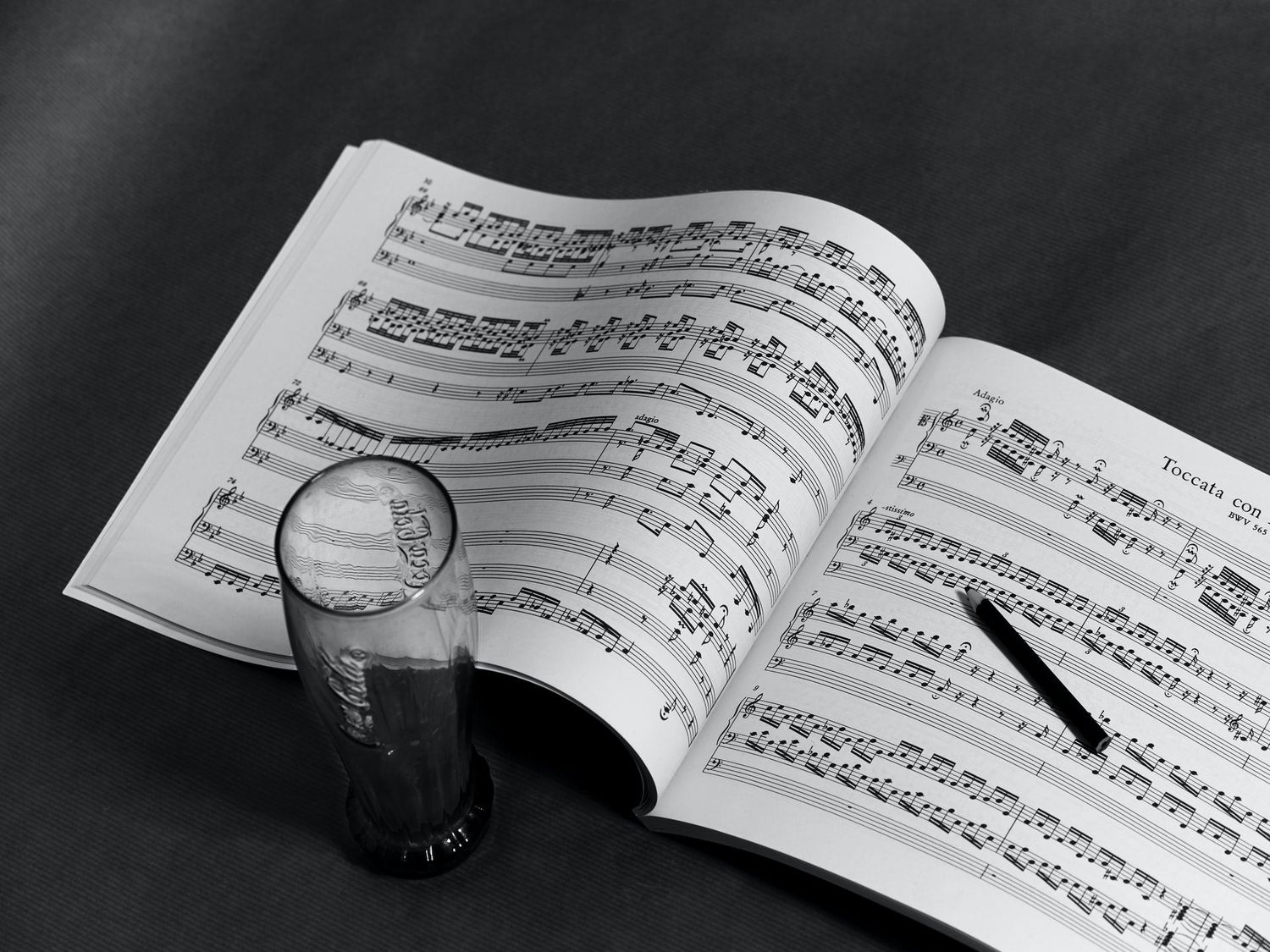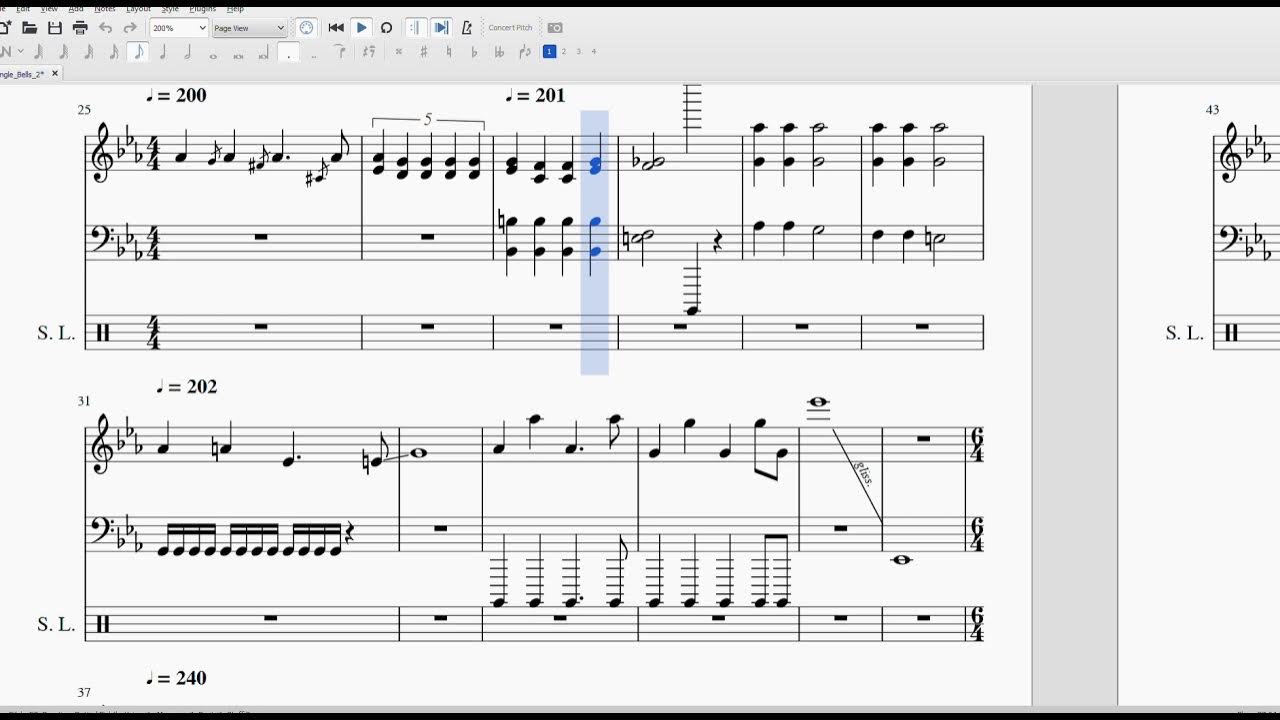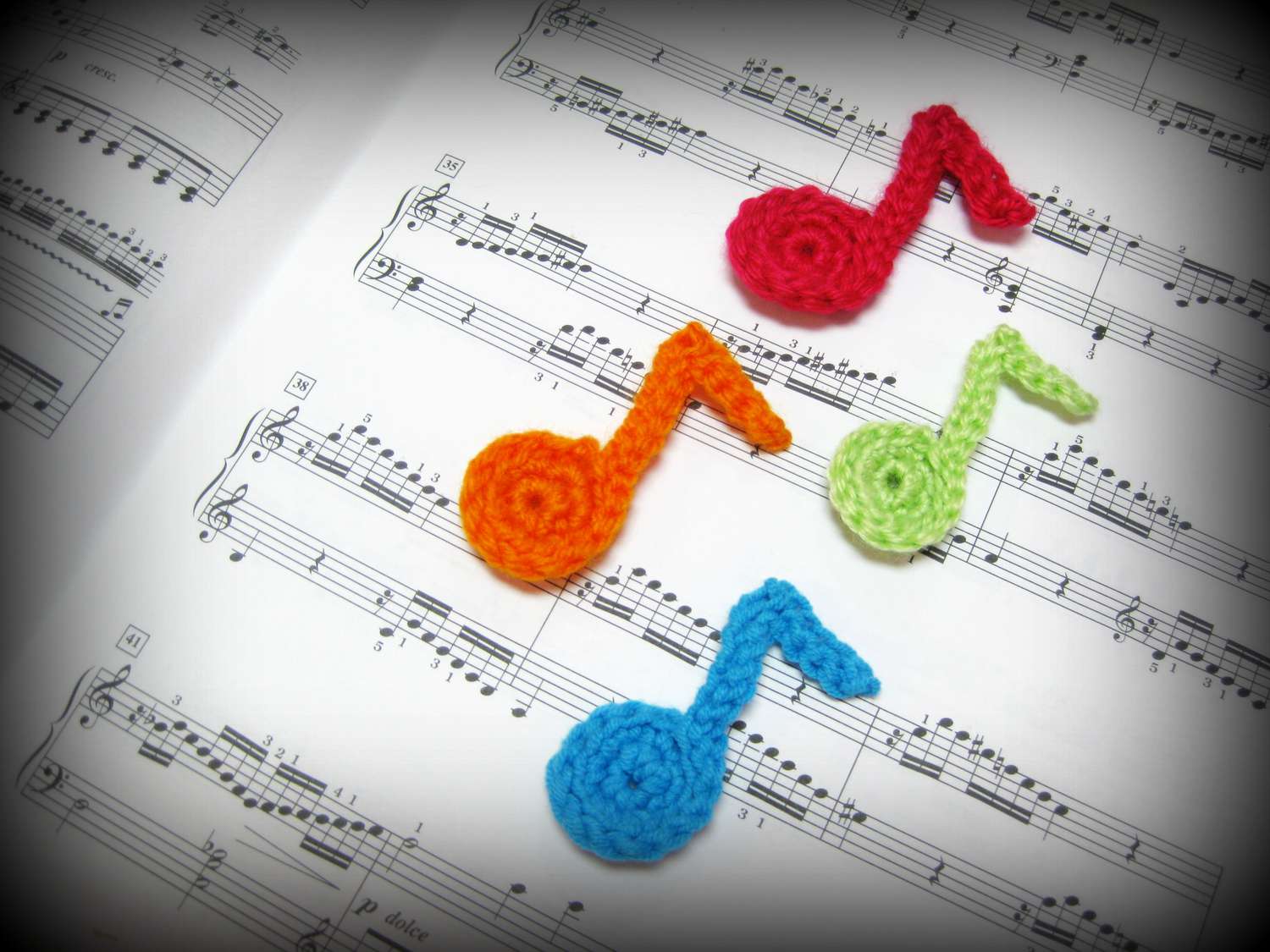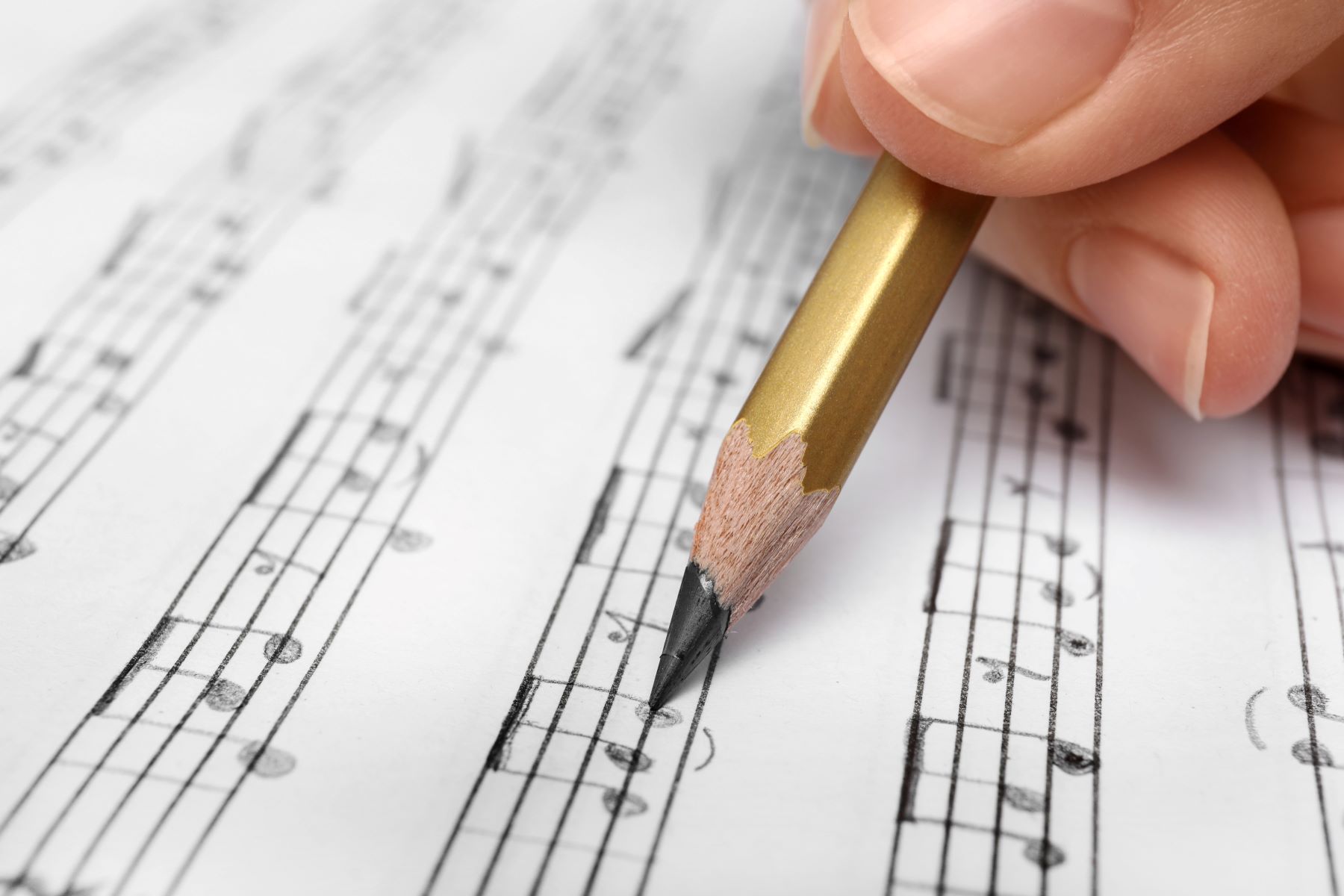Home>Production & Technology>Music Theory>Music Theory How To Write A Melody
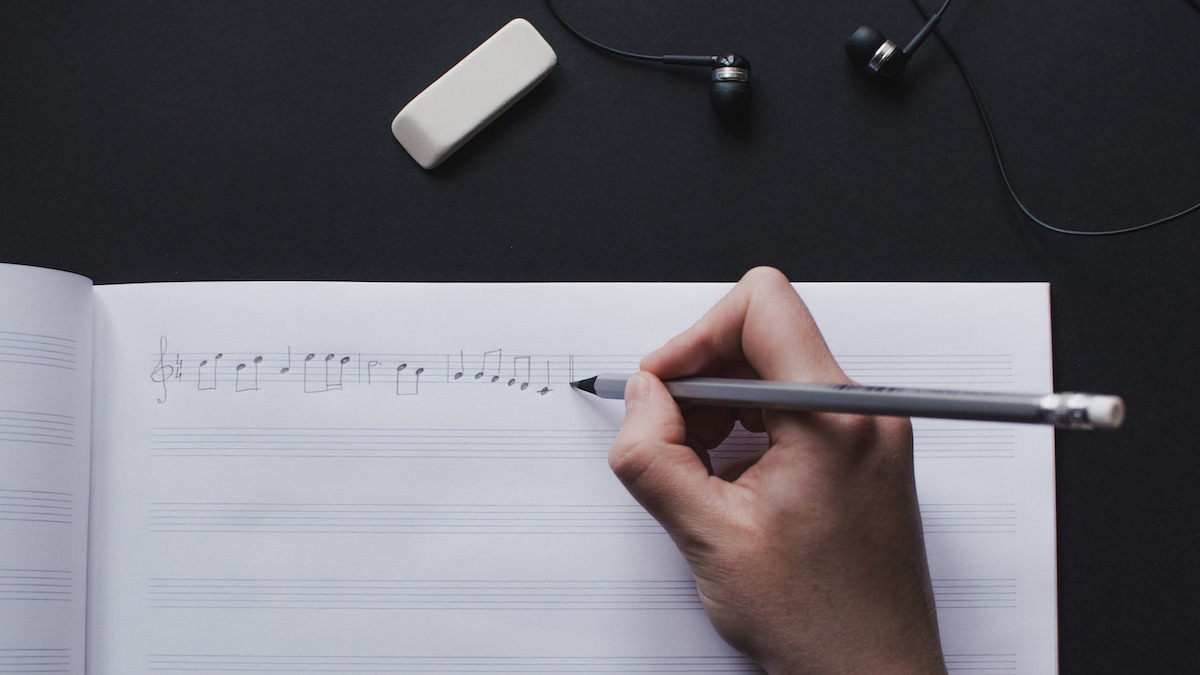

Music Theory
Music Theory How To Write A Melody
Published: January 30, 2024
Learn the fundamentals of music theory and discover how to write captivating melodies with our comprehensive guide on music theory. Master the art of composition with ease.
(Many of the links in this article redirect to a specific reviewed product. Your purchase of these products through affiliate links helps to generate commission for AudioLover.com, at no extra cost. Learn more)
Table of Contents
- Introduction
- Understanding Melody
- Step 1: Choosing a Key
- Step 2: Establishing a Tonality
- Step 3: Determining a Time Signature
- Step 4: Selecting a Tempo
- Step 5: Exploring Melodic Structure
- Step 6: Creating Motifs
- Step 7: Building a Melodic Phrase
- Step 8: Using Chords to Support the Melody
- Step 9: Adding Harmony to Enhance the Melody
- Step 10: Developing and Varying the Melody
- Conclusion
Introduction
Music theory is the backbone of creating and understanding music. It provides a set of rules and guidelines that help musicians compose, analyze, and interpret musical compositions. One of the fundamental aspects of music theory is melody, which is the sequence of musical notes that forms the main theme of a piece.
Writing a compelling melody is essential for capturing the listener’s attention and evoking emotions. Whether you’re a songwriter, composer, or simply an aspiring musician, understanding the principles of melody can greatly enhance your music-making abilities.
In this article, we will explore the process of writing a melody from scratch. We will cover everything from selecting a key and establishing tonality to creating motifs, building phrases, and adding harmonies to enhance the melody.
Before we dive into the technical aspects, it’s important to note that melody is not merely a series of random notes. It is an arrangement of pitches, rhythm, and structure that when combined, create a cohesive and memorable musical line. A well-crafted melody can stay with someone long after the song is over, making it a crucial aspect of any musical composition.
Throughout this article, we will guide you through the process of creating a melody step by step. So, whether you are a beginner or have some experience in music theory, this guide will provide valuable insights and techniques to help you write captivating melodies.
Understanding Melody
Before we delve into the process of writing a melody, it’s important to have a solid understanding of what a melody is and how it functions within a musical composition.
A melody is a series of musical notes played or sung in succession. It is the most prominent and memorable part of a song or piece of music. Melodies are created by combining different musical elements, such as pitch, rhythm, and phrasing, to create a coherent and expressive musical line.
Pitch is the perceived frequency of a musical sound. It is the element that gives each note its distinct identity. Melodies are built with a combination of high and low pitches, creating a sense of movement and emotional expression.
Rhythm refers to the pattern and duration of notes in the melody. It gives the melody a sense of groove, pace, and timing. The rhythm of a melody can be simple or complex, depending on the desired musical style or genre.
Phrasing is the way in which a melody is divided into smaller musical phrases or sections. It helps to create a sense of structure and coherence in the overall melody. Phrases are often used to create tension and release, and can be thought of as musical sentences or phrases.
In addition to pitch, rhythm, and phrasing, melodies are also influenced by the key, tonality, time signature, and tempo of a musical composition. These elements provide a framework and context for the melody, shaping its overall character and mood.
A key is a particular set of pitches or notes that form the basis of a composition. It establishes the tonal center or “home” note, around which the melody revolves. Choosing the right key for a melody is crucial as it determines the overall sound and feel of the piece.
Tonality refers to the relationship between the notes of a melody and the chosen key. It determines whether the melody is in a major key (bright and happy) or a minor key (sad and melancholic). Tonality plays a significant role in conveying the emotional content of a melody.
Time signature and tempo are important rhythmic elements that influence the pacing and feel of a melody. The time signature dictates the number of beats in each measure and the tempo determines the speed at which the melody is played or sung.
Having a solid understanding of these fundamental elements of melody will provide the foundation for creating compelling and effective melodies. In the next sections, we will dive deeper into the process of writing a melody, exploring each step in detail.
Step 1: Choosing a Key
Choosing the right key is the first step in the process of writing a melody. The key sets the tonal center of the composition and determines the collection of notes that will be used in the melody.
When selecting a key, consider the mood and style you want to convey. Different keys have distinct characteristics and evoke different emotions. For example, the key of C major is often associated with a bright and joyful sound, while the key of A minor is often associated with a melancholic and introspective feel.
Try experimenting with different keys to see which one resonates with the desired emotional impact of your melody. You can also consider the range of the instrument or voice that will be performing the melody. Certain keys may be more comfortable and fitting for specific instruments or vocal ranges.
Additionally, think about how the chosen key will relate to other elements of the composition, such as the harmony and chords. The key will determine the available chords and harmonies that can be used to support the melody. It’s important to ensure that the chosen key allows for a harmonic progression that complements and enhances the melody.
Once you have chosen a key, make a note of the key signature, which is a series of sharps or flats at the beginning of the musical staff. The key signature indicates which notes are altered throughout the composition, allowing musicians to easily read and perform the melody.
Remember that the choice of key is subjective, and there are no rules set in stone. Trust your artistic instincts and choose a key that resonates with you and the emotions you wish to convey through your melody. The key sets the foundation for the rest of the melody-writing process and will greatly influence the overall character and mood of your composition.
Step 2: Establishing a Tonality
Once you have chosen a key for your melody, the next step is to establish the tonality. Tonality refers to the relationship between the notes of a melody and the chosen key, determining whether the melody sounds major, minor, or modal.
In a major tonality, the melody will have a bright and happy sound. Major tonalities are often associated with feelings of joy, excitement, and positivity. They are commonly used in uplifting and celebratory compositions.
In a minor tonality, the melody will have a sad, melancholic, or dark sound. Minor tonalities evoke feelings of sadness, yearning, and introspection. They are widely used in emotional and introspective compositions.
Modal tonalities, on the other hand, provide a unique and distinct sound. Modes such as Dorian, Phrygian, and Mixolydian offer different tonal flavors and can bring a sense of exoticism to the melody.
To establish the tonality, you can start by focusing on the root or tonic note of the key. This is the note that provides the sense of stability and resolution in the melody. You can emphasize the tonic note by starting and ending phrases on it or by using it as a recurring motif throughout the melody.
Next, consider the intervals and melodic patterns that define the chosen tonality. For example, in a major tonality, melodies often utilize major intervals such as the major third and perfect fifth to create a bright and uplifting sound. In a minor tonality, melodies often incorporate the minor third, creating a sense of melancholy.
However, don’t feel limited by the traditional expectations of tonality. Experiment with bending and blurring tonal boundaries to create unique and unexpected melodies. Combining elements of major and minor tonalities or incorporating modal inflections can add depth and interest to your composition.
Remember that tonality is not solely dependent on the choice of notes, but also on the relationships and context within the melody. The interplay between tension and resolution, dissonance and consonance, and the use of passing tones and embellishments contribute to the overall tonal character and expressiveness of the melody.
By establishing a clear tonality in your melody, you can guide the listener’s emotional response and create a coherent and impactful musical journey. The choice of tonality adds a layer of depth and complexity to your composition, making it an essential step in the process of writing a melody.
Step 3: Determining a Time Signature
After choosing the key and establishing the tonality of your melody, the next step is to determine the time signature. The time signature defines the rhythmic structure of the melody by specifying the number of beats in each measure and the type of note that receives one beat.
The time signature consists of two numbers written at the beginning of the musical staff. The top number indicates the number of beats per measure, while the bottom number represents the note value that receives one beat. For example, in a 4/4 time signature, there are four beats per measure, and the quarter note receives one beat.
When determining the time signature for your melody, it’s important to consider the rhythmic feel and desired pacing. Different time signatures create distinct rhythmic patterns and can greatly influence the overall groove and character of your composition.
A common time signature is 4/4, also known as “common time.” It provides a steady and straightforward feel, with four beats per measure, where the quarter note receives one beat. This time signature is widely used in various musical genres, from pop and rock to classical and jazz.
Other common time signatures include 3/4, often associated with waltzes and giving a flowing and graceful feel, and 6/8, which creates a compound, dotted rhythm with a strong emphasis on the first beat and a triplet subdivision.
More complex time signatures, such as 7/8 or 5/4, can add an intriguing and asymmetrical feel to your melody. These time signatures challenge the listener’s expectation and create a sense of uniqueness and complexity.
Consider the melodic patterns, rhythmic motifs, and phrasing you plan to use in your melody. Different time signatures may better accommodate specific rhythmic patterns or syncopations. Experiment with different time signatures to find the one that best complements and enhances the rhythmic structure of your melody.
Ultimately, the choice of time signature should support the overall feel and intention of your composition. It should provide a rhythmic framework that allows your melody to flow naturally and engage the listener. By selecting an appropriate time signature, you can further enhance the rhythmic depth and complexity of your melody.
Step 4: Selecting a Tempo
Once you have determined the time signature for your melody, the next step is to select a tempo. Tempo refers to the speed at which the melody is played or sung, and it plays a crucial role in setting the mood, energy, and overall feel of your composition.
The tempo is typically indicated at the beginning of the musical score using Italian terms such as “Andante” (a moderate pace), “Allegro” (a quick and lively pace), or “Largo” (a slow and broad pace). These terms provide a general sense of the desired tempo, but they can be further defined by specifying the beats per minute (BPM).
When selecting the tempo for your melody, consider the style, genre, and emotional content you want to convey. Different tempos evoke different emotions and have a significant impact on the overall character and energy of the composition.
A slower tempo, such as Adagio or Lento, can create a contemplative, reflective, or somber mood. This tempo is often used in ballads or introspective pieces where the melody takes center stage and allows for more emotional depth and expression.
In contrast, a faster tempo, such as Allegro or Vivace, brings a sense of excitement, energy, and joy. This tempo is common in upbeat and lively genres like pop, rock, or dance music, where the melody drives the energetic pulse of the composition.
Remember that the tempo you choose should complement the melodic patterns and rhythmic motifs in your composition. Make sure that the tempo allows for comfortable execution and showcases the desired rhythmic intricacies of your melody.
It can be helpful to tap out the rhythm of your melody or listen to reference songs with similar characteristics to get a sense of the appropriate tempo. Don’t be afraid to experiment and adjust the tempo as you go, depending on how well it aligns with the emotional intention and musical flow of your melody.
Overall, selecting the right tempo for your melody is crucial for capturing the desired mood, energy, and emotion. It sets the pace and rhythmic drive of the composition, enhancing the overall impact and engagement of your melody.
Step 5: Exploring Melodic Structure
Now that you have established the key, tonality, time signature, and tempo for your melody, it’s time to explore the melodic structure. The melodic structure refers to the organization and arrangement of the musical notes within the composition.
There are various approaches to structuring a melody, and it largely depends on the style, genre, and artistic choices you wish to pursue. Here are a few common melodic structures to consider:
- Linear Structure: This structure follows a straightforward and linear progression, often moving stepwise or using simple melodic intervals. It provides a clear and easy-to-follow melody that can be effective in conveying simplicity and directness.
- Repetitive Structure: In this structure, melodic patterns or motifs are repeated throughout the composition, creating a sense of unity and familiarity. Repetition helps to establish a memorable and recognizable melodic theme.
- Call and Response Structure: This structure involves a distinctive call phrase followed by a response phrase. It creates a dialogue-like interaction between different melodic ideas, adding interest and tension to the composition.
- Contrasting Sections: Another approach is to create distinct sections within the melody that contrast in terms of pitch, rhythm, or melodic contour. This can include a verse-chorus structure or the use of contrasting melodies in different sections of the composition.
- Developmental Structure: This structure involves the development and transformation of melodic ideas throughout the composition. It allows for exploration and variation, keeping the listener engaged and interested.
Consider the goals and emotions you want to convey through your melody. Experiment with different melodic structures to find the one that best suits your artistic vision. Remember that variations in rhythm, pitch, and phrasing can add interest and complexity to your melody, so don’t be afraid to explore different possibilities.
As you explore melodic structure, pay attention to the balance between repetition and variation. Repetition can create a sense of coherence and familiarity, while variation adds interest and keeps the melody evolving. Strive for a melodic structure that is cohesive, engaging, and tells a musical story.
Ultimately, the melodic structure should serve as a framework for your composition, guiding the listener through a musical journey. It should provide a sense of direction and purpose, enhancing the emotional impact and experience of your melody.
Step 6: Creating Motifs
In the process of writing a melody, one of the key elements to focus on is the creation of motifs. A motif is a short, distinct melodic idea or phrase that serves as the building block for your melody.
Creating strong and memorable motifs is essential for crafting a captivating melody. A well-crafted motif can become the recognizable and signature element of your composition, making it instantly recognizable to the listener.
When creating motifs, you can draw inspiration from a variety of sources. It could be a catchy rhythm, a distinctive interval, or a unique melodic contour. Experiment with different combinations of notes, rhythms, and patterns to find a motif that resonates with you.
Here are a few strategies for creating motifs:
- Simplicity: Start with a simple and concise idea. A short melodic phrase using a few notes can be just as effective as a long and complex one. Remember that simplicity can enhance the memorability and catchiness of your motif.
- Rhythmic Patterns: Explore different rhythmic patterns to give your motif a sense of rhythm and groove. Syncopation, accents, and repeated rhythmic figures can add a dynamic and energetic quality to your melody.
- Intervallic Movement: Experiment with intervals to create interesting melodic contours. The use of leaps, steps, or repeated notes can add variety and character to your motifs. Consider using intervals that evoke the desired mood or emotion of your melody.
- Motivic Development: Once you have created a motif, you can develop it by altering certain elements. This could include transposing the motif to a different pitch, varying the rhythm, or adding embellishments. Motivic development adds depth and interest to your melody.
- Repetition and Variation: Use repetition and variation techniques to strengthen your motifs. Repeating a motif throughout the melody creates coherence and familiarity, while varying it slightly adds interest and avoids monotony.
Remember that motifs can be used not only in the main melody but also in supporting melodies, countermelodies, or accompaniment parts. Consistency and integration of motifs throughout the composition can create a cohesive and unified musical work.
Take the time to experiment, refine, and develop your motifs. Play them on your instrument, sing them, and listen to them in different musical contexts. Pay attention to how they fit within the overall melody and how they interact with other elements of the composition.
Creating unique and interesting motifs is a crucial step in the process of writing a melody. They provide the foundation for the rest of the melody and contribute to its overall impact and memorability. So, let your creativity flow and explore the endless possibilities of motif creation.
Step 7: Building a Melodic Phrase
Once you have established motifs for your melody, the next step is to build melodic phrases. A melodic phrase is a musical sentence or a complete musical thought that expresses a coherent idea within your composition.
Building a melodic phrase involves arranging the motifs and adding melodic elements to create a well-rounded and expressive musical statement. Here are some key considerations to keep in mind:
- Contour: Consider the shape and direction of your melodic phrase. It can have an ascending, descending, or wave-like contour. Contour plays a significant role in conveying emotion and creating tension and release within your melody.
- Breathing Space: Allow for moments of rest and space within your melodic phrase. The strategic use of rests and pauses can add emphasis and enhance the overall rhythm and flow of your melody.
- Dynamic Contrast: Experiment with dynamic fluctuations to add contrast and interest to your melodic phrase. Use crescendos and decrescendos to create a sense of tension and release, and vary the intensity to convey different emotions.
- Rhythmic Variation: Explore rhythmic variation within your melodic phrase. Vary the length and placement of notes to create rhythmic interest and to highlight certain melodic elements.
- Phrase Connectivity: Aim to create a smooth and seamless connection between melodic phrases. Use transitional elements or overlapping notes to create a sense of continuity and flow between phrases.
- Anticipation and Resolution: Create moments of anticipation and resolution within your melodic phrases. This can be achieved through the use of leading tones or by building tension leading up to a particular note or phrase, followed by a satisfying resolution.
As you build your melodic phrases, consider the underlying rhythmic structure and the harmonic progression that supports your melody. Ensure that the melodic phrases align with the rhythm and fit harmonically within the overall composition.
Experiment with different combinations of motifs, rhythms, and melodic ideas. Don’t be afraid to explore different melodic possibilities, incorporating both familiar and unique elements to create a compelling and memorable melodic phrase.
Furthermore, listen to your melody as you build each phrase. Allow your ear to guide you in terms of what sounds musically pleasing and expressive. Trust your intuition and make adjustments as necessary to create a melody that resonates with both you and your listeners.
Remember that building a melodic phrase is an iterative process. It’s important to revise and refine your melodic ideas, ensuring that each phrase flows seamlessly into the next, creating a cohesive and captivating musical narrative.
By focusing on each melodic phrase as a standalone idea while also considering its place within the larger composition, you can create a melody that engages the listener and tells a compelling musical story.
Step 8: Using Chords to Support the Melody
Now that you have built your melodic phrases, it’s time to consider the role of chords in supporting and enhancing your melody. Chords provide harmonic support and create a foundation for the melodic elements of your composition.
Harmony refers to the simultaneous sounding of different pitches or chords, and it adds depth, richness, and emotional impact to your melody. The choice of chords can greatly influence the overall mood, tension, and resolution within your composition.
When using chords to support your melody, consider the following:
- Harmonic Progression: Determine the chord progression that fits well with your melody. The harmonic progression should enhance the emotional content of your melody and create a sense of development and resolution. Experiment with different progressions to find the one that complements your melody’s tonality and mood.
- Chord Voicings: Explore different chord voicings to add color and texture to your composition. Experiment with inversions, extensions, and altered chords to create a unique harmonic landscape.
- Root Movement: Pay attention to the movement of the root notes within the chords. Smooth and connected root movement can create a sense of flow and continuity in supporting your melody.
- Chord Duration: Decide how long each chord will last in relation to the melody. Some chords may be held for longer durations to provide a sense of stability and support, while others may be used as passing chords to add interest and harmonic tension.
- Chord Substitutions: Consider using chord substitutions to add variety and unexpected harmonic twists to your composition. Substituting chords within the harmonic progression can create moments of surprise and musical interest.
- Contrast and Balance: Aim for a balance between consonance and dissonance in your chord choices. Explore chords that create tension and release, providing a compelling backdrop for your melody.
Remember that the chords should complement and enhance the melodic phrases, creating a cohesive and harmonically rich composition. Harmonic choices should serve the overall musical goals, supporting the emotions and intentions expressed through your melody.
As you experiment with chord progressions, listen carefully to how they interact with your melody. Pay attention to the harmonies created and how they elevate or alter the melodic character. Don’t be afraid to make adjustments and revisions to ensure that the chords and melody work harmoniously together.
By using chords to support your melody, you not only add depth and richness to your composition but also create harmonic interest and structure. The interplay between chords and melody can create a powerful and engaging musical experience for both you and your audience.
Step 9: Adding Harmony to Enhance the Melody
In the process of writing a melody, adding harmonies is a crucial step to enhance and elevate the overall musical composition. Harmony refers to the simultaneous sounding of two or more musical notes, creating a vertical layer of sound that complements and supports the melody.
When adding harmony to your melody, consider the following:
- Chord Selection: Choose chords that align with the underlying key and tonality of your melody. The chords should create a harmonic foundation that supports and enriches the melodic ideas. Experiment with different chord qualities (e.g., major, minor, dominant) to achieve the desired emotional impact.
- Progressions and Transitions: Craft chord progressions and smooth transitions that provide a logical and satisfying harmonic flow. Consider the melodic movement and phrasing when deciding when to change chords and how to create tension and release within the harmony.
- Chord Inversions: Utilize chord inversions to add variety and interest to the harmony. Inversions alter the order of notes within a chord, allowing for smoother voice leading and creating unique harmonic colors.
- Voice Leading: Pay attention to the movement of individual voices within the harmony. Smooth voice leading ensures that the transitions between chords are seamless and that the overall harmonic progression flows naturally.
- Counterpoint: Consider incorporating elements of counterpoint, which is the art of combining multiple melodic lines. Creating melodic lines that harmonically interact and intertwine with the main melody can add complexity and depth to the composition.
- Embellishments and Extensions: Experiment with embellishments and chord extensions to add richness and color to the harmony. This can include adding seventh chords, suspensions, and other extended harmonies to create a more complex and sophisticated harmonic texture.
When adding harmonies, it’s important to strike a balance between supporting the melody and creating interesting harmonic movement. The harmony should enhance the emotional impact of your melody without overpowering it.
As you explore different harmonies, listen closely to how they interact with your melody. Pay attention to the emotions they evoke and the overall mood they create. Consider how different chord voicings and inversions affect the color and character of the harmony.
Remember that harmony and melody are interconnected and should work harmoniously together. When done right, harmony can bring depth, complexity, and emotional impact to your composition, creating a satisfying and immersive musical experience.
Step 10: Developing and Varying the Melody
The final step in the process of writing a melody is to develop and vary the melodic ideas you have created. Developing and varying the melody involves adding musical interest, complexity, and dynamics to captivate the listener and avoid monotony.
Here are some techniques to effectively develop and vary your melody:
- Repetition with Variation: Repeat certain motifs or phrases with slight modifications to create a sense of familiarity and continuity, while also introducing new elements to keep the melody fresh and engaging.
- Sequencing: Apply a melodic sequence, which is a pattern that repeats on different pitches, to add forward motion and expand on the melodic ideas. This technique can create a sense of tension and resolution within the melody.
- Embellishments: Add embellishments, such as trills, slides, or ornaments, to decorate certain notes and bring expressive flair to the melody. These embellishments can add nuance and variation, enhancing the overall performance and emotional impact.
- Changing Rhythmic Patterns: Modify the rhythmic patterns of the melody to introduce new dynamics and interest. This can involve altering note durations, syncopation, or rhythmic accents to create a different rhythmic feel while maintaining the core melodic structure.
- Key Changes: Consider introducing key changes within the melody to create contrast and add depth to the composition. Transitioning to a different key can evoke a change in mood or emotion, providing a fresh perspective and musical surprise.
- Dynamic Contrast: Experiment with dynamic variations in your melody, such as crescendos, decrescendos, or accents. Utilize softer and louder dynamics strategically to highlight certain melodic phrases and to convey different emotions throughout the composition.
- Countermelodies: Introduce countermelodies that intertwine and harmonically interact with the main melody. This technique adds complexity and layers to your composition, providing a rich and textured musical experience.
By developing and varying your melody, you add depth, interest, and progression to your musical composition. It allows you to explore different facets of the melodic ideas and maintain the listener’s attention throughout the piece.
As you incorporate these techniques, trust your ear and musical intuition. Listen to how the variations and developments interact with the original melody and the overall composition. Make adjustments and revisions as needed to ensure a cohesive and satisfying musical journey.
Remember that melody is a powerful tool for communication and expression. Don’t be afraid to take risks, experiment, and let your creativity shine through as you develop and vary your melody.
Ultimately, through thoughtful development and variation, your melody will become a dynamic and captivating musical centerpiece that resonates with both you and your audience.
Conclusion
Writing a melody is a creative and rewarding process that requires careful consideration of musical elements and a deep understanding of music theory. Throughout this guide, we have explored the steps involved in crafting a compelling melody, from choosing a key and establishing tonality to developing and varying the melodic ideas.
Understanding the fundamental elements of melody, such as pitch, rhythm, and phrasing, is essential for creating a coherent and memorable musical line. By selecting the right key, tonality, time signature, and tempo, you set the foundation for a successful melody that resonates with your intended emotions and artistic vision.
Incorporating motifs, building melodic phrases, using chords and harmonies, and practicing development and variation techniques all contribute to the depth, complexity, and expressiveness of your melody. These techniques help keep your composition engaging, dynamic, and musically intriguing.
Throughout the process, always trust your artistic intuition and let your creative instincts guide you. Be open to exploring different possibilities, taking risks, and continually refining your musical ideas. Remember that effective melody writing combines technical knowledge with artistic expression.
Writing a captivating melody requires practice, patience, and a willingness to delve into the depths of music theory. Take the time to experiment, listen, and refine your melodies, always striving to create a musical experience that resonates with both you and your listeners.
Whether you are a songwriter, composer, or aspiring musician, understanding the art and science of melody writing is a valuable skill to have. By following the steps outlined in this guide and infusing your creativity, you are well-equipped to embark on the journey of creating extraordinary melodies in your musical compositions.

